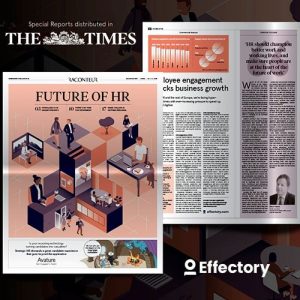It’s already been seven years since Effectory switched from a traditional organizational structure to completely self-managed industry teams. What if we could take a trip back in time to the moment just before we made that switch? Looking back, would we do the same?
Effectory seven years after the transition to self-management

Self-management is being mentioned a lot in the news today. After a few organizations were extremely successful deploying it, self-management became a hype. And as with every hype, after the initial celebration, a phase of criticism followed. The Dutch company Cordaan, specialist in district nursing and homecare, even switched back to the traditional way of working. In a blog recently shared by the Dutch online magazine Skipr, Amir Sharafkhani, advisor at Twynstra Gudde, shows how self-managing teams get stuck and have a hard time making decisions. He paints the picture of teams having to carry out so many additional tasks that they’re not getting round to their main responsibilities.
Effectory’s story
Does this sound familiar to us? Yes, it does. Self-management is not the holy grail, and getting there is a bumpy road. At Effectory, we are not experiencing ‘the seven year itch’ though. And after seven years we still see more pro’s than cons. Looking at the impact our new way of working has, we would say 80% is positive. 20% is a little less wonderful. This 80% is not linked to how we get things done, that changes quite frequently. For example, when we just started off, each team had a team captain. After a while they weren’t necessary anymore. Other aspects we are still exploring include the best way to share financial information with employees and the extent to which our management should provide frameworks and guidelines. The way we self-manage is always changing.
And that is its power. After seven years, the number one benefit of self-management is our ability to adapt to changing circumstances together. This is an ongoing process, sparked by an external event or the internal motivation to improve our performance. If an approach isn’t working, employees are free to choose a different one. At first we did wonder how to organize decision making and internal alignment. But now we are more adaptable to change and able to respond to changes quicker. Of course self-management has it’s cons too, that’s the 20%. Below we will discuss both the benefits as well as the downsides of self-management.
The Future of HR Special Report
Technology is changing how HR will function in the future. This report explores the impact of AI & big data plus how to use employee engagement for growth.
DownloadThe benefits
The value our teams offer to clients has improved, due to short lines of communication and industry-focus, which means our employees feel like fish in ‘their own’ water. Customer satisfaction increased from an 8.4 to an 8.9, and we added Effectory-users to all industries. Our targeted focus also enabled a huge international growth.
Benefits:
- Teams are perfectly attuned and fully focused on ‘their industry’
- Teams are guided by conscious and healthy business insights
- Employees and organizational interests are aligned. Employees are entrepreneurs, which increases engagement and commitment.
- Employees are open to change and feel involved. They take initiative, which leads to more innovation and offering services that truly match our customer’s needs.
The cons
Besides pro’s, there are also cons. These are the most important:
- Teams usually consist of about fifteen people with different tasks and roles. When a few people leave in rapid succession, this has a negative impact. We significantly reduced this, by working with larger teams and shared responsibilities.
- Holding employees accountable and letting go of employees that aren’t performing is still tough. Who will take the lead? This was a challenge at first, but we are improving. The organization is maturing.
- Because of the flat organizational structure, employees feel there’s less growth opportunities. With no management role in sight, it takes more effort to keep employees motivated. We have had to place more emphasis on personal development and growing in your own role.
The organization of the future
The future belongs to innovative, agile organizations that have a clear social mission. Agility is important to stay successful in a dynamic environment. Every organization needs to keep reinventing themselves, and their structure. Because social and technological trends are fast-moving, there is less time for traditional reorganization. Ideally, organizations should match their internal evolution to the external flow of change. Listening to your employees and anticipating trends will help you do so! If you make tweaks along the way, you will never have to reorganize.
Fully leveraging the talents of your employees benefits your business. More than that, it is necessary to turn your strategy into a succes. An engaged employee costs the same as an employee that is not engaged, but brings more to your business. He or she is more effective, more innovative and more customer-orientated. The perfect organizational structure makes sure the social responsibility of your organization and employee- and business interests are in balance.
Increasing responsibility in the lower part of your organization is one way to improve the agility of your organization. If done well, this will also have a positive impact on how engaged, committed and responsible your employees are.
Book a free demo. See our solutions in action.
Effectory is Europe’s Leading provider of Employee Listening Solutions. Schedule a product demo and discover how to enhance your employees’ engagement.
Demo request
